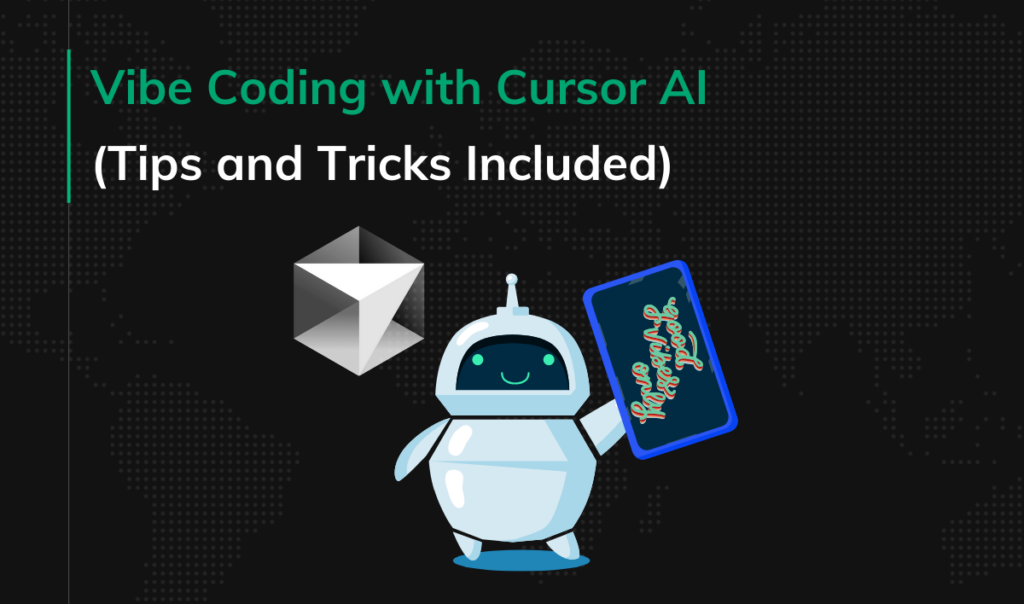How to generate new product ideas? Guide to the solution discovery process for startups
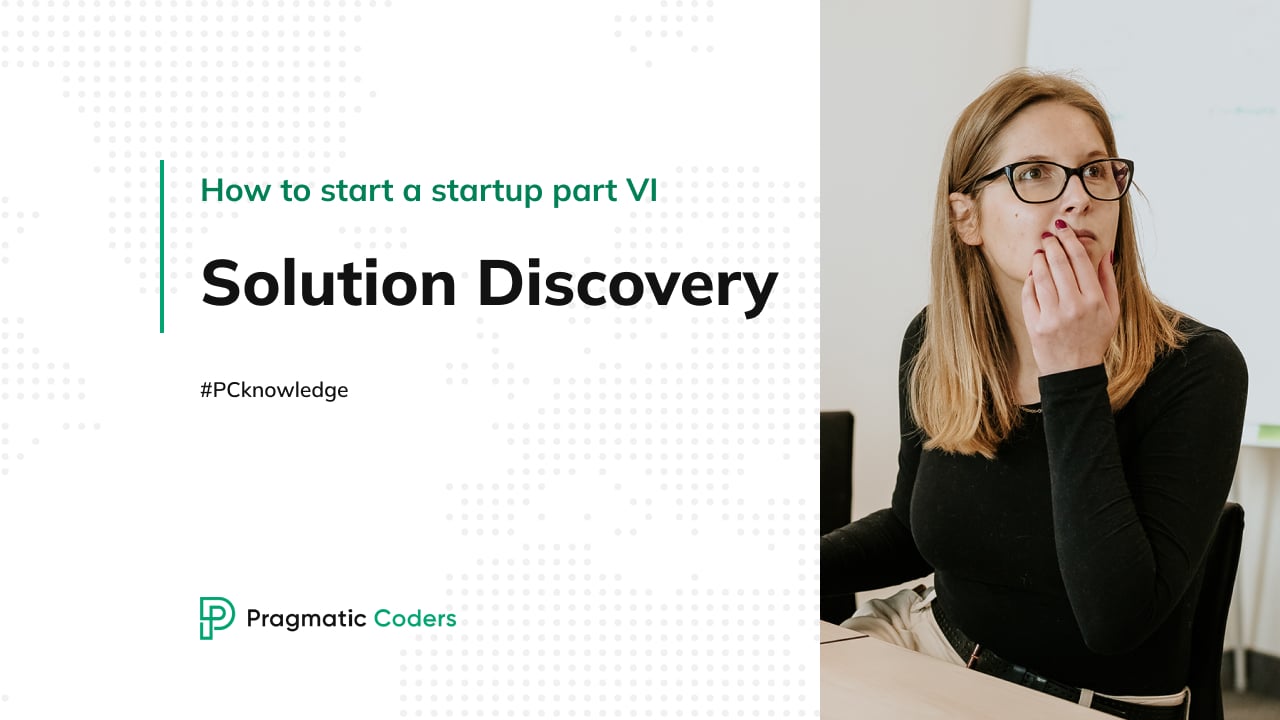
We often see companies trying to develop their products right from the get-go. It’s easy to blindly assume that your business idea is perfect and will undoubtedly bring profit. And we don’t want to burst your bubble, but without the discovery process, it’s nearly impossible to achieve success.
The discovery process helps us get the foundations right before deciding on development which is why it’s a crucial step. Proper research, being part of the discovery process, allows us to uncover the problems, goals, and motivations of our potential users. Only after knowing that information can we start thinking of whether there is any potential in developing a product.
In this article, as the title says, we’ll take you through the Solution Discovery process. We will also take a look at how to use different ideation methods to come up with various solution ideas and decide which ones are worthy of further investigation. Let’s get started!
What is Solution Discovery?
As mentioned above, Solution Discovery focuses on identifying how you can solve the most impactful user problem. It is during this stage that the team working on the project gets together to brainstorm a list of possible solutions, which will later be prioritized. So by the end of this process, you should end up with an accumulated amount of possible solutions, out of which a few will be later considered for validation.
What’s worth mentioning here is that the Solution Discovery process doesn’t necessarily have to revolve around finding the solution to a new problem. It can also be about figuring out how to improve an existing solution or leveraging an opportunity in the market. When analyzing your competitors, you may notice that their products are lacking in certain aspects. This may leave you wondering why they haven’t invested in those particular areas of their product. Perhaps this can be your gateway to finding your niche.
- During the Solution Discovery process, you can think of how to find a solution that addresses those particular areas. An example of this can be how DuckDuckGo evolved into a successful company despite bold competitors like Google. Taking advantage of the fact that Google’s privacy policy concerned certain users, DuckDuckGo built a search engine that would allow users to take control of their personal information. And although DuckDuckGo is still far behind the search engine giant that is Google, its impressive and inspiring story proves that with a good understanding of your target audience, you can create a successful product!
The correlation between Solution Discovery and Solution Definition
The ultimate goal of Solution Discovery is to avoid creating waste and find the right solution as quickly as possible. At this stage, you focus on weeding out the ideas that obviously won’t work (for example, they wouldn’t fit within your budget). As you cross off more solution ideas from your list, you get closer to selecting the right one.
However, as you make your way toward the Solution Definition stage, it can be harder to reject solution ideas. Due to this, it’s important to keep in mind that the line between Solution Discovery and Solution Definition can get a bit blurry as these two steps are very closely intertwined, and the process of finding the right solution is an iterative one. At any point, you may realize that you need to go back and do more research to fill in knowledge gaps.
How to prepare for Solution Discovery
Before you start searching for different solutions, it’s vital to have a good understanding of the problem you will tackle. This is done throughout the problem discovery and definition process, where you conduct different types of research and analyze the gathered information to select a problem.
This is why conducting proper UX research is of key importance, as it allows you to take a deep dive into the world of your potential users to discover their needs, pain points, goals, behaviors, motivations, and mental models. The knowledge gained during that stage will inspire your train of thought when brainstorming different solutions. Without grasping the user’s needs and problems correctly, it will be extremely difficult to come up with something that makes sense.
Who takes part in Solution Discovery?
Your team should be made up of:
- A UX team that consists of a UX researcher (who previously worked on conducting your user research) and a UX designer who understands how to approach the proposed solutions design-wise. These specialists will keep an eye out for usability risks that they notice in the proposed solution ideas.
- A Product Owner who brings in their knowledge of the market and competitors.
- A Tech Leader who gives feedback regarding the feasibility of the solution ideas and provides information regarding the technology that would be required to build them.
It is said that teamwork makes the dream work. And this is absolutely true in this case! Each of these individuals will bring their knowledge to the table and provide valuable insights throughout the process. Through cross-functional collaboration, you can address all of the risks that may show up right at the beginning. This means that you can rapidly evaluate some of your ideas and turn down those that would be difficult or impossible to create due to different limitations. This, in turn, ensures that you are doing all you can to lower the likelihood of building the wrong product.
Product risk taxonomy
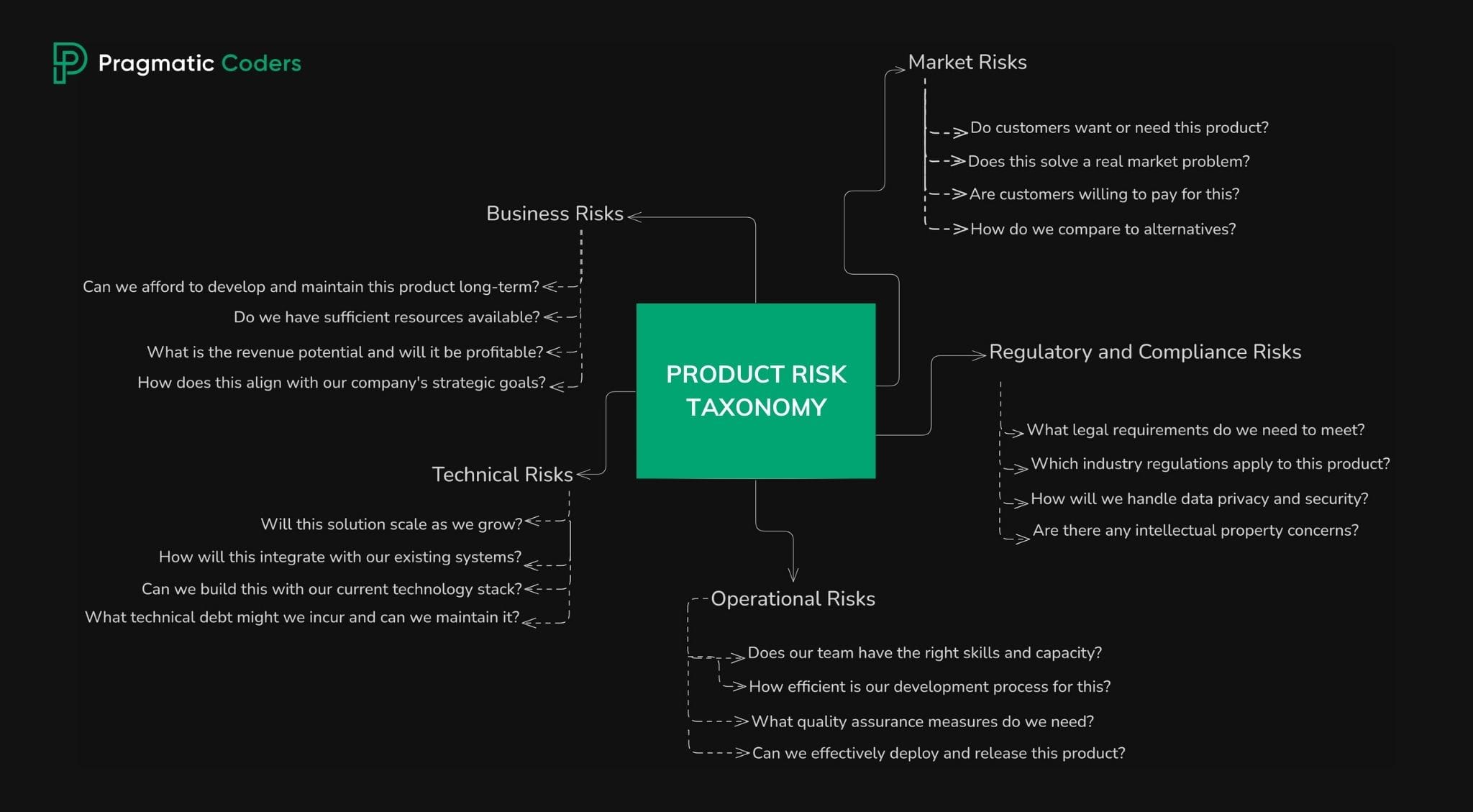
Solution discovery is the process of finding and validating the right solution to a customer problem. The Product Risk Taxonomy plays a crucial role in this process because it helps teams identify potential obstacles before and during the discovery phase, which directly influences how solutions are explored and validated.
Think of it as a comprehensive map that helps product teams identify and manage potential challenges before and during product development.
Ideation and prioritization methods
Your goal at this stage is to find a few solutions that you think would work and select a single one that you want to test as the first one (because you are confident that this solution idea has the highest chance of success). By setting some solution ideas aside, you have a “backup plan” that you can come back to if things go south during the validation process, and it turns out that you were mistaken and chose the wrong solution idea.
Impact Mapping
This is a 4-level framework that lets you organize your findings from your research. Based on that knowledge, you can come up with the deliverables (which, in this case, are the solution ideas). Using this method, you work with a given user problem (or a business goal that you can translate into a user problem), the actors, and the impacts your solution will have on the actors.
Let’s break down each of these levels:
- Why – the “why” can be defined as a user problem that you want to solve. For example: “People don’t purchase bus tickets.”
- Who – the “who” or the “actors” are all of the people affected by this problem. This means not only the end user but also, for example, the company’s management, customer service, etc. In our example, the problem affects not only the passengers but also the ticket inspector and the bus company’s management.
- How – this is where you define the “impacts” your solutions will have on the “actors.” Some of the impacts in our example may be: “an easy way of purchasing tickets” or “selling tickets faster.”
- What – finally, you get to the “what” stage, which is the “deliverables.” This is where you generate all of the solution ideas that create those impacts and contribute to the goal. You can come up with ideas for specific products (for example, an app that allows you to purchase tickets) or features for that product (a notification that reminds you to buy a ticket).
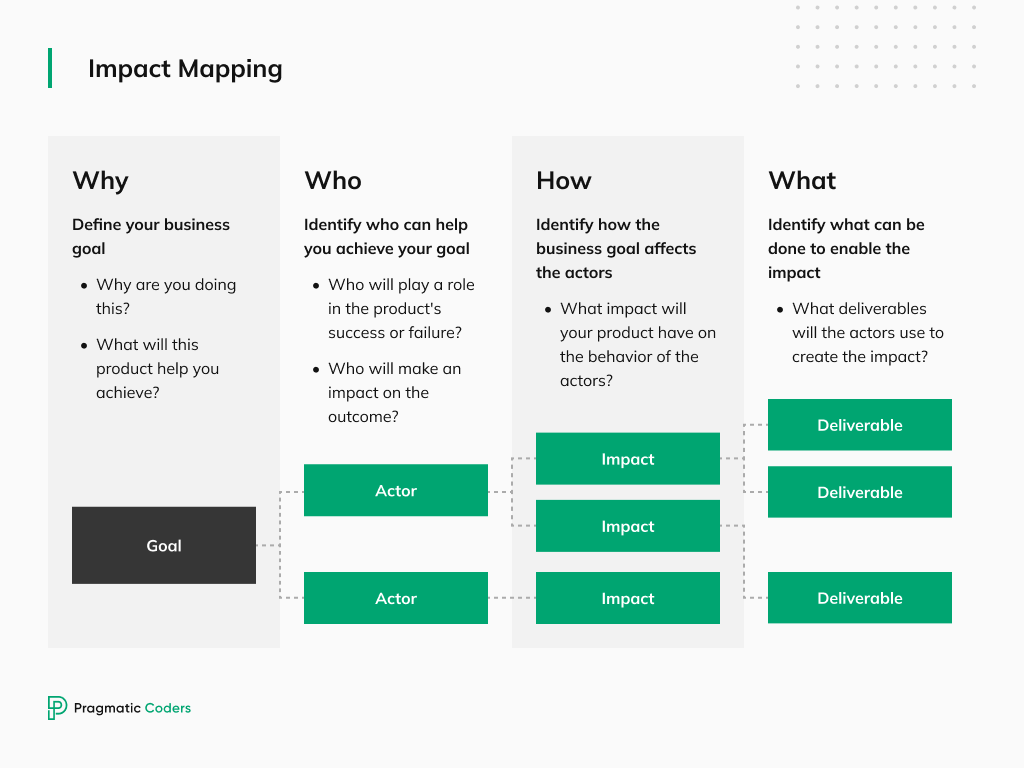
Broadly speaking, this method is all about looking through the lens of the problem, understanding how it influences the user, and trying to find the best solutions for it. What you should end up with is a map consisting of many branches. Your team’s job is to find the path that is the most impactful and select the solutions that enable you to achieve your business goal and solve the user problem.
To utilize this method correctly, you must be sure that information found during the user research has been carefully analyzed since this data makes up the first three levels of impact mapping. A helpful method for seeing what problems the users are dealing with and their attitudes toward it is affinity mapping, which we have explained in our article about conducting UX research.
Opportunity solution tree
You can probably already tell that this method is fairly similar to impact mapping just by looking at it. In this case, however, you focus more on the outcome instead of the impact that your solution would bring. The structure of an Opportunity solution tree consists of 4 layers:
- Outcome – this is the result that you want to achieve. It should account for your user needs and align with your business goals.
- Opportunities – next, you identify the opportunities which are less detailed compared to the impacts from the previous exercise (you can fit many impacts into one opportunity) and consider the problems and needs your users have.
- Solutions – at this point, you get to the part where you brainstorm different ideas for solutions that address the opportunities defined in the previous stage.
- Experiments – this is where opportunity solution trees differ from impact mapping. With this method, you go one level deeper and test your solutions to check whether they make sense or not.
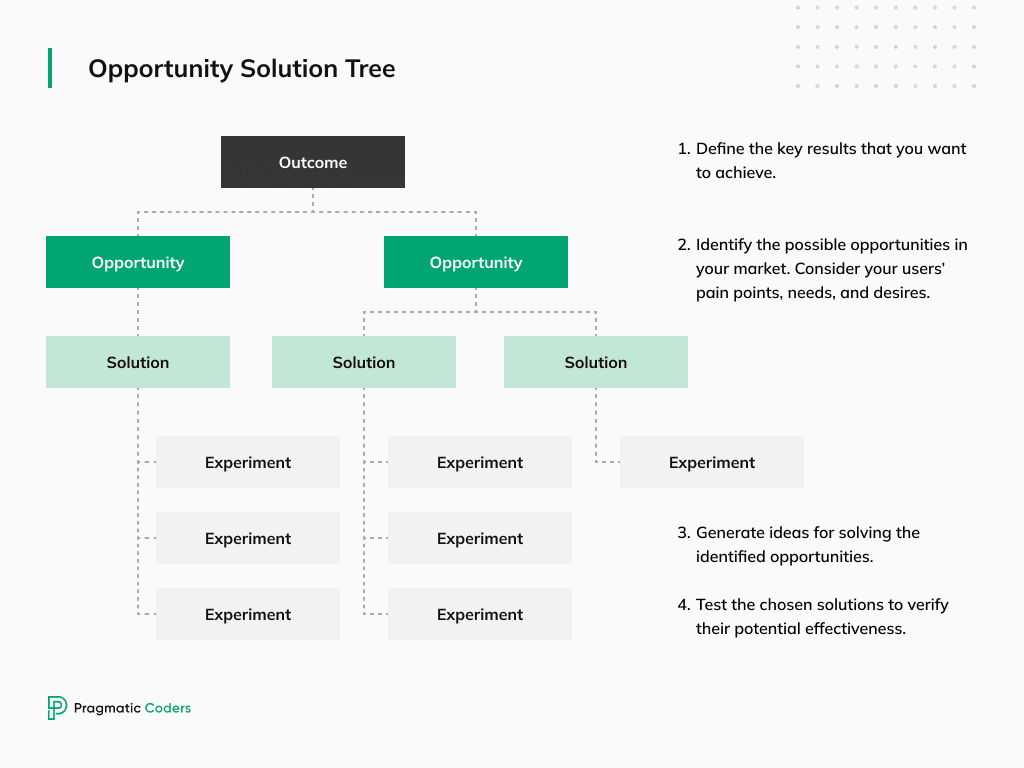
Remember that at this stage, you are not validating your solutions, but you are focusing on which ones to reject. Therefore, you should use the least expensive methods to check the ideas. As you get closer to defining your solution, you can invest more time and money into testing.
Paper Prototypes
Paper prototyping is a process that involves creating simple sketches, which are the paper representation of a digital product. This method allows you to quickly create general overviews of what your product would look like. It is used by the designers to visualize the solution ideas that have been brainstormed by the team. Paper prototypes are great as conversation starters and can be used for discussing the proposed solution ideas. The ideas can then be thrown away ideas or adjusted on the fly, thanks to the input provided by all of the team members.
User interviews
You may want to involve your potential customers as early as possible in the solution phase because their feedback can help understand what adjustments need to be made for a better user experience. Although usability testing and user interviews are methods used when you have a more elaborate solution to present, you can also use these methods during the discovery process. However, in this case, you aim to see how your potential users react to the solution idea. So how do you go about doing this? You can prepare a selection of mockups that present your solution and show them to the users to learn what they think about it and observe their reactions. What you can also do is only present your users with certain elements of a solution (perhaps the ones that are most important to us) to see if the users would understand how those features would work.
The outcomes of this process
Finding the possible solutions
In the best-case scenario, by the end of this process, you will have come up with a bunch of solutions that you are ready to investigate further in the next stage, which is the Solution Definition. Additionally, at this stage, a lot of the information that is uncovered will later help you understand how you can structure your product in a way that is understandable for the users. Thanks to this, you have the base of your Information Architecture which will gradually be built and become more refined as you make progress and get closer to the definition of your solution.
Not finding any solutions
It is entirely possible that some of the solutions you came up with are not the right ones. This is also a great outcome because by understanding what doesn’t work, you avoid wasting your time and resources on it. If you didn’t find any solutions, this is your sign to turn around and go back to check if the problem you want to solve is, in fact, a real problem.
Some of the reasons why you can’t come up with any solutions are:
- You haven’t considered all of your options, and the solution is still out there waiting to be found.
- You don’t have the possibility to move forward with any of the solutions due to certain restrictions (a limited budget, for example).
- You have chosen the wrong problem (this problem isn’t significant), and you need to return to the problem discovery stage.
Bottom Line
There you have it! Hopefully, after reading this article, you now understand:
- The meaning behind Solution Discovery
- How Solution Discovery and Solution Definition overlap
- The importance of having the right set of team members
- And the various methods you can use to ideate and prioritize solutions
So what do you do next? At this point, there are two routes you can take:
- Bring your findings to the next stage (Solution Definition), by the end of which you will select a single solution idea and validate it.
- Circle back to the problem stage and deepen your knowledge by doing another round of research.
In our next article, we will take a look at the Solution Definition stage and how to validate your solution before preparing it for launch.




